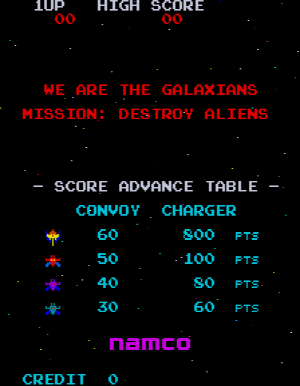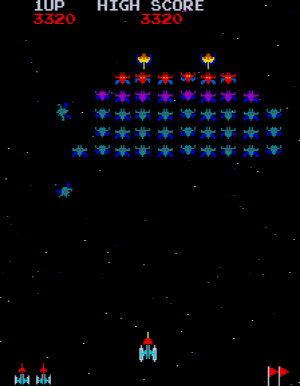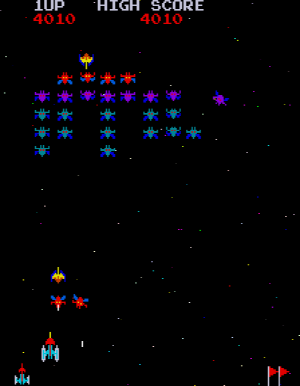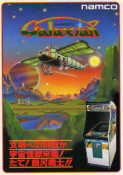Yeah, Galaga overshadowed this to such an extent, I keep forgetting Galaxian exists. I do like revisiting it from time to time though.
Galaxian Review Rewind
|
|
See PixlBit's Review Policies

On 06/14/2021 at 02:00 PM by Jamie Alston In space, it's always cicada season. |

If you want to delve into the history of vertical shooters, this should be on your list.
If you live anywhere in the northeastern United States like me, your space is likely being invaded by the periodical cicada brood this time of year. After experiencing the terror of having one smack me in the eye the other day, I realized that these critters share some interesting commonalities with the insects in the arcade classic Galaxian. They’re red-eyed, noisy in groups, and will eagerly dive-bomb you as if “Ride of the Valkyries” were blasting in the background. If you told me cicadas were the inspiration behind this game, I’d totally believe you.
Before we get into the review proper, let’s take a brief look at the game’s history. Galaxian was created by Namco game designer Kazunori Sawan. After witnessing the success of Taito’s Space Invaders, the President of Namco tasked Sawan’s team with turning Galaxian into the next big arcade hit. The enemy characters were initially designed to resemble TIE Fighters from the Star Wars film but were later changed to be insect-like mechanized creatures. Galaxian was a sight to behold with the technical accomplishments of being one of the first arcade games to feature full-color visuals and a scrolling starfield to simulate vertical movement.

At first glance, one might dismiss this game as a prettier Space Invaders knockoff and nothing more. For indeed, they share the same basic premise- shoot down each row of aliens while they move horizontally in unison and fire back at you. But that is where the similarities end. Graphical differences aside, Galaxian ups the ante since the enemies aggressively break formation attempting to ram your ship while firing missiles at various intervals. If they miss, they’ll rejoin the convoy and take turns attacking you.
Your ship- which the game calls “Galaxip”- can only fire a single shot at a time and must either hit an enemy or reach the end of the screen before you can shoot again. This creates tension any time you miss, especially if an enemy is approaching. They often attack in a meandering zig-zag pattern to either extreme side of the screen.
Thanks to the Galaxip’s leisurely rate of fire, a large part of the challenge involves staying alert to which side the enemies are descending to dodge them properly. Occasionally, some will perform a somersault just before rejoining the squadron, adding an element of surprise to the unsuspecting player. When you whittle their forces to just a few, the remaining enemies all attack at once without regrouping (unless they destroy you).

Your biggest worries are the two flagships on the top row. Each will attack with an escort of two wingmen (provided you haven’t destroyed them already). The scoring system also plays a significant role since the amount of points awarded depends on whether or not the enemy is actively attacking. Sure, you can easily pick off the fleet while most are still in formation, but destroying an individual ship moving in for the kill is worth double the points. Taking down a flagship mid-flight can net you up to roughly 13x the base point value, assuming you destroy both wingmen first. It’s an engaging risk/reward system, especially if you want to acquire the bonus stock ship quickly.
Galaxian was also unique for its sound design. It was one of the earliest examples of using a synthesizer to produce sound effects for the game. In a similar vein as Space Invaders, each round begins with a slowly pulsating tone that gradually speeds up as you destroy the enemy fleet. It suggests a sense of desperation for both the antagonists and the player trying to take them down. When an enemy swoops down to attack, they emit a whistling noise that lowers in pitch as they descend to the bottom of the screen. The audio presentation, though simplistic, adequately sells the action.
Based on my positive words about the game’s overall quality, one might expect that I’d give it a higher review score than the one awarded. However, I cannot ignore that the game is hampered somewhat by the passing of time. In the 40+ years since its release, vertical shooting games have evolved into far grander ventures than merely destroying the same enemy formations with a single shot-firing ship over and over again until you eventually lose the game.

After completing the first stage, you’ve seen all the game has to offer; gradual difficulty increases aside. And while that’s not in itself a bad thing, it won’t likely hold your attention the way it would have in its heyday- especially if you’ve already experienced the sequel Galaga and beyond. However, the game is still worth playing, if nothing more than for historical context.
If you’re interested in owning this Galaxian, you can easily find it in one of the many Namco Museum compilations available in some way on most major gaming platforms. Though it may not impress quite like it used to, the game still leapfrogged the offerings of Space Invaders and played a pivotal role in paving the way for scrolling shoot-em-ups to truly blossom. As a fan of the genre, I say that makes this game worthy of the utmost respect.










Comments